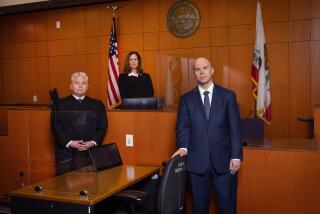Courts to Keep Security Tight
Airport-style security measures, implemented two months ago at the downtown County Courthouse because of terrorism fears sparked by the start of the Gulf War, will remain in place for the foreseeable future, court officials decided Monday.
The war ended Feb. 27 with a cease-fire. But a panel of area judges voted late Monday to go ahead with earlier plans to bolster security at the downtown courthouse by adding an X-ray machine to the metal detector put in place shortly after war erupted in mid-January, officials said.
Beginning five years ago, Marshal Mike Sgobba said Monday, he had urged the addition of both the X-ray machine and the metal detector, saying that the Federal Courthouse across Broadway had both devices. But it took bomb threats linked to the Jan. 16 beginning of the war to persuade county judges to immediately implement airport-style measures, he said.
Two months later, after detecting 306 knives, 55 containers of mace, seven stun guns and one firearm on the way into the downtown courthouse, Sgobba and San Diego Superior Court Judge Judith McConnell said a sense of increased safety at the court outweighs the added costs and occasional inconvenience of the stepped-up security.
“The numbers of weapons seized at front door, from people told (by signs) that they will be subject to search and that it’s a felony to bring weapons into the courthouse, is phenomenal and terrifying,” said McConnell, the presiding judge of the Superior Court.
“There are so many cases going on involving people who are dangerous, let’s put it that way, that it (added security) has increased a lot of people’s level of confidence about being in this building,” McConnell said.
In late February, a metal detector and X-ray machine were installed at the county court annex in Vista, Sgobba said. In early March, the El Cajon courts got metal detectors and an X-ray machine, he said. The panel of judges voted Monday to keep those measures in place, too.
The committee, which sets the courthouse security policies that the marshal’s office carries out, is made up of about a dozen Superior and Municipal Court judges from around the county, said its chairman, Vista Superior Court Judge Franklin Mitchell.
In less than a month in El Cajon, deputy marshals confiscated 170 weapons, Sgobba said. Another 1,100 items, mostly knives and scissors, were turned away but not taken away, Sgobba said.
Most of the knives and scissors go back to someone’s car, Sgobba said. But some people are hiding items in the bushes near the court rather than walk to a car, causing concern that “children playing in the area may find them and injure themselves,” he said.
In Vista, deputy marshals have detected 306 weapons, 271 of which were knives, Sgobba said. Nine of the 306 were actually seized, he said.
After adding in costs from Vista and El Cajon, the added security tab appears to be about $6,000 extra a month, mostly in salary and overtime, Sgobba said.
Staffing costs ought to decrease when more X-ray machines arrive, in two or three months, because the machines will screen packages that deputy marshals now have to check by hand, Sgobba said. The machines themselves cost $25,000 each, he said.
For years, both the Juvenile Court building in Clairemont Mesa and the Family Court on 6th Avenue in San Diego have had an X-ray machine and a metal detector. Combined statistics from both sites show that, from November, 1987, through February, 1991, deputy marshals seized 5,466 knives and razors, 139 Mace containers and 39 stun guns, Sgobba said.
Marshals at the two courts also seized 847 “miscellaneous” items, defined as tools, explosives, ammunition, axes and throwing stars, Sgobba said.
The Municipal Court in Chula Vista does not have any airport-style measures because judges there have not been convinced they are helpful, Sgobba said.
At the central County Courthouse, which houses dozens of Superior and Municipal Courtrooms, Sgobba and McConnell said, the metal detector has prompted surprisingly few complaints. “The only complaint I’ve received is from someone who complained that his knife was taken away from him,” McConnell said.
State law allows knives up to 4 inches long inside a county courthouse. But Sgobba’s policy is no knives, because it would take too much time to measure blade after blade, he said.
Since January, deputy marshals have made a handful of arrests at the downtown courthouse for possession of illegal drugs and one arrest for carrying a gun without a permit, Sgobba said.
Last Friday, a juror in a murder trial was arrested after she passed through the metal detector and marshals found what they said appeared to be crystal methamphetamine in her purse. On Monday, juror Miriam Taylor-Fisher, 33, was excused from the case, in which Stacy Butler is charged with shooting a San Diego police officer, a court clerk said.
The only entrance to the building has been limited to the Broadway side, and doors on C Street, Union Street and elsewhere have been shut, meaning jurors, witnesses and the just plain curious must endure lines of 10 or 15 minutes both before court begins and again at the end of lunch breaks.
Lawyers and court staff may enter through a special entrance on Broadway that avoids the detector.
More to Read
Sign up for Essential California
The most important California stories and recommendations in your inbox every morning.
You may occasionally receive promotional content from the Los Angeles Times.









